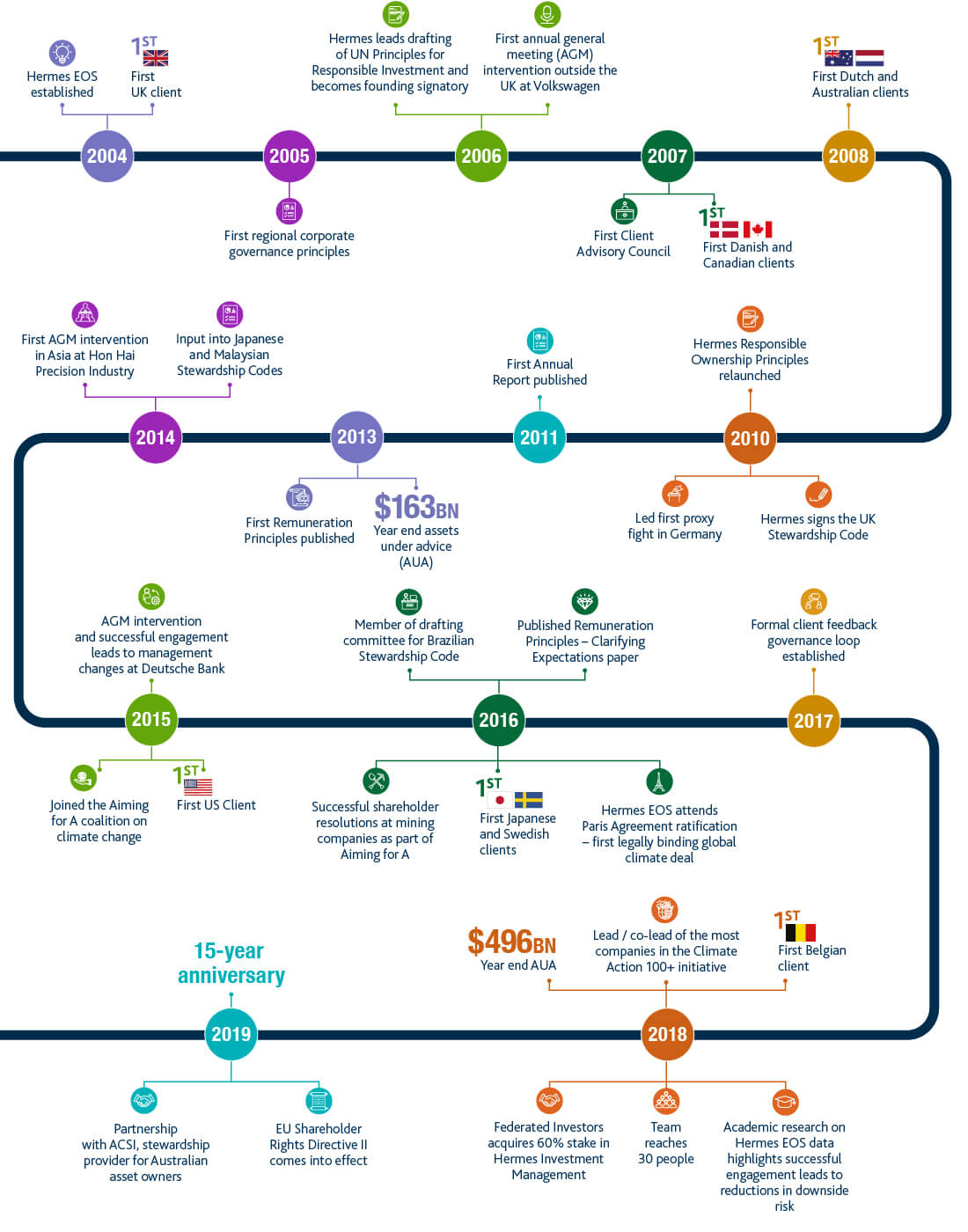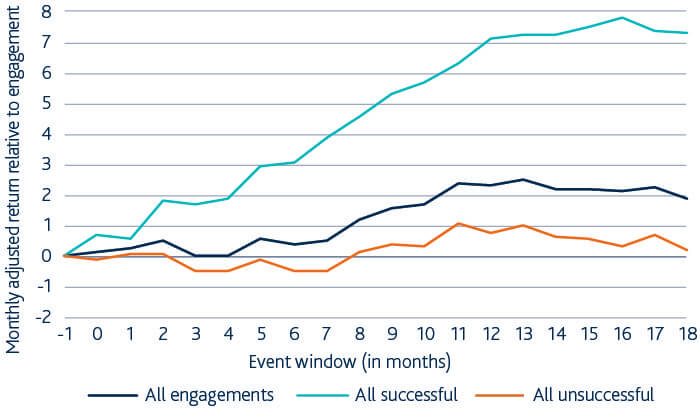Setting the scene
Stewardship is in our DNA. More than just voting shareholdings at annual meetings, stewardship includes screening, monitoring and engaging with companies on matters that impact long-term value creation, such as strategy, capital structure, performance, risk, corporate governance and culture, and material environmental and social issues. But the road to mainstream acceptance has been far from smooth.
Back in 2004, engagement was underused and underdeveloped – screening and divestment were easier if asset managers wanted to burnish their responsible investment credentials. But for long-term institutional investors with large equity allocations, this was less than ideal.
Hermes had taken some early steps in stewardship through a dedicated corporate governance team and concentrated Focus Funds, which identified companies with governance issues and sought to improve them. Seeing the success of this approach mainly in the UK, our then owner, the BT Pension Scheme, strongly encouraged us to scale this up and engage systematically with key holdings around the world.
Serendipitously, another large pension fund sought our help on stewardship around the same time. A dedicated engagement team was set up, and as Hermes Investment Management was named after the messenger of the gods, the name EOS was chosen after the rosy-fingered goddess of the dawn, while also standing for Equity Ownership Services.
Initially, there were some significant hurdles to overcome. Many mainstream investors were yet to be convinced of the value of engagement, while companies were often unused to board-level dialogue with investors on long-term issues and could be resistant or unhelpful.
But changes were afoot. A major report published in 2004 coined the term ESG, and in 2006 the UN invited a group of the world’s largest institutional investors to develop the Principles for Responsible Investment (see timeline). But a catalyst to drive real change was needed.
Timeline: Hermes EOS through the ages

Source: Hermes EOS, as at October 2019.
Turning points
The financial meltdown of 2007-8 forced market participants to rethink their approach and ask what they needed to do to avoid such painful losses again. We relaunched our Responsible Ownership Principles, and developed a milestone system to track our progress in engagements. We also signed the UK Stewardship Code, which encouraged institutional investors to engage on corporate governance on behalf of their underlying beneficiaries.
And then in 2012, investors started to vote against what were seen as disproportionate executive pay packets in the shareholder spring. Reflecting this concern, we developed our remuneration principles with the help of other investors and major companies.
Building momentum
Although adoption of stewardship remained low across the asset management industry, supportive data would help to erode some of the scepticism towards engagement (see Figure 1). More pension funds started to realise that stewardship made sense from a financial perspective, not just an ethical standpoint.
Figure 1: Engagement linked to enhanced financial performance

Source: A 2012 study by Elroy Dimsona, Oğuzhan Karakaşb, and Xi Lic analysed an extensive database of corporate social responsibility engagements with US public companies over 1999–2009 addressing environmental, social, and governance concerns. Engagements are followed by a one-year abnormal return that averages +1.8%, comprising +4.4% for successful and zero for unsuccessful engagements. Past performance is not a reliable indicator of future results.
The upsurge in interest from asset owners meant that companies had to pay attention. Institutional investors were now working collaboratively to move the needle at companies and the momentum was building to a point where ESG engagement was poised to enter the mainstream.
Nowhere was this clearer than in environmental risk, where the increasingly dire warnings from scientists about climate change had become impossible to ignore. And on the governance agenda, change was also taking place in the US, frequently led by the use of shareholder resolutions.
Greater transparency
Greater focus and awareness at the asset owner and beneficiary level prompted a push for more transparency around engagements. At Hermes EOS, that led to the development of a detailed engagement plan, with companies and themes chosen in a systematic way. To formulate the plan, we consult stewardship clients about their priorities and the most material issues on which we need to engage companies.
We disclose the results of our activities through our company case studies and other reporting, and advocate for the adoption of best practice and improved standards through our public policy work.
The road ahead
The dangers of ignoring poor corporate governance will always serve as a stark warning, but investors are increasingly focused on the climate crisis, with the toughest battles still ahead.
Short-termism remains a faultline of markets, with some asset managers paying lip service to stewardship but reluctant to challenge companies effectively.
To truly come of age, stewardship must move to the heart of investment activities rather than being secondary to the buying and selling of securities. This will mean significant resourcing, and a shift in focus from policies and processes towards outcomes. Investors will want to see where stewardship is having the greatest impact, and who is really able to deliver results.
This commentary was adapted from the Q2 2019 Public Engagement Report by Hermes EOS.








